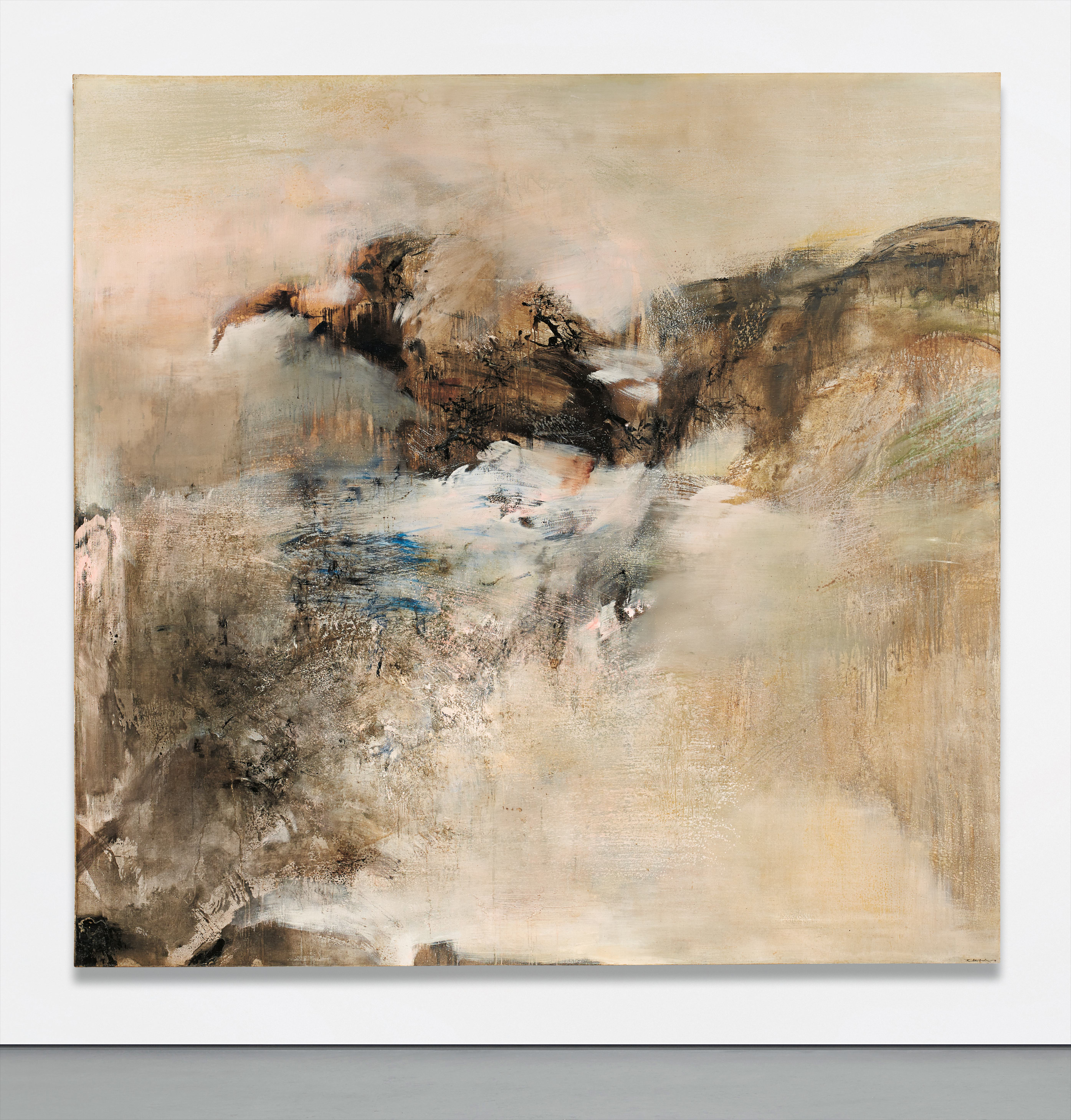

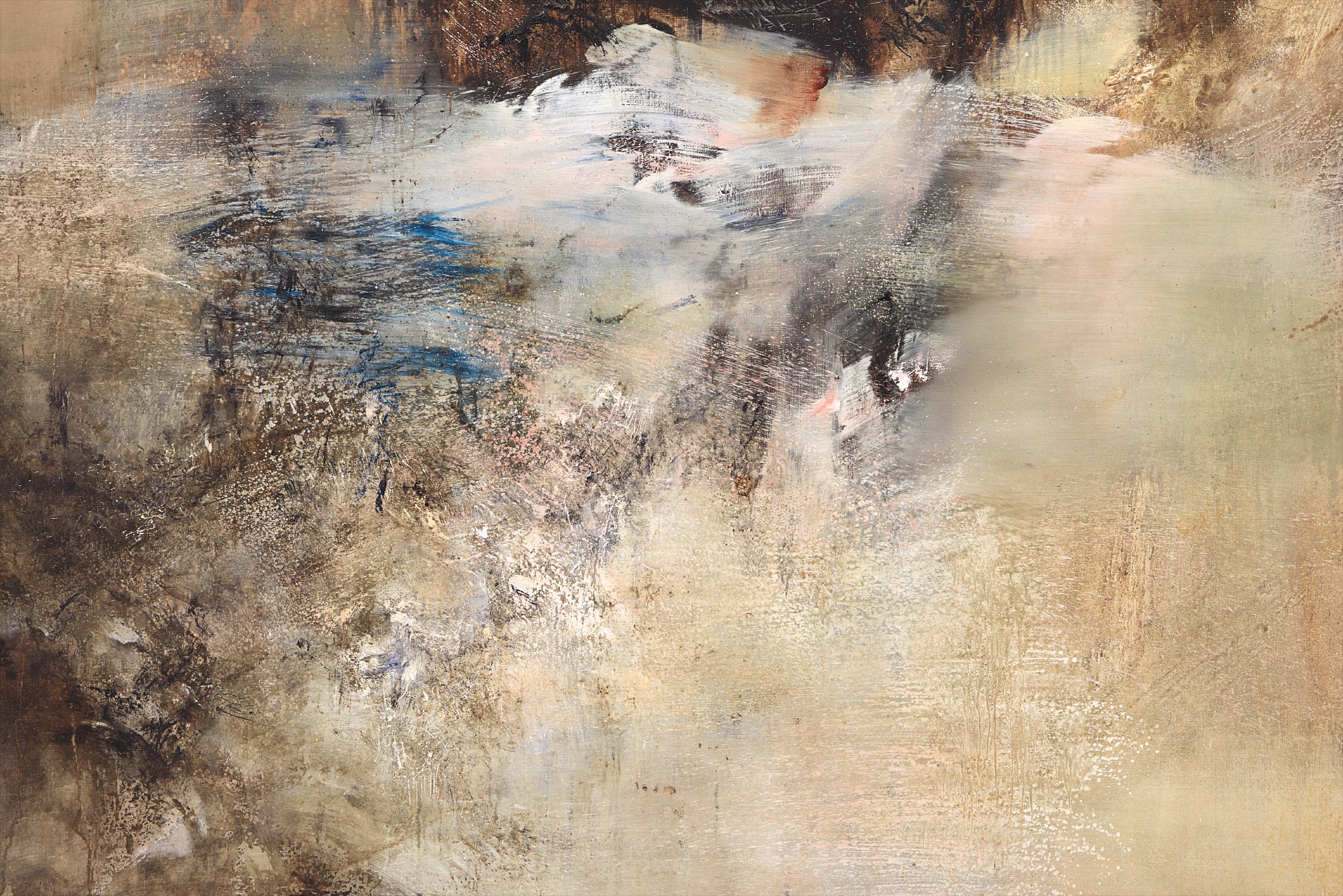
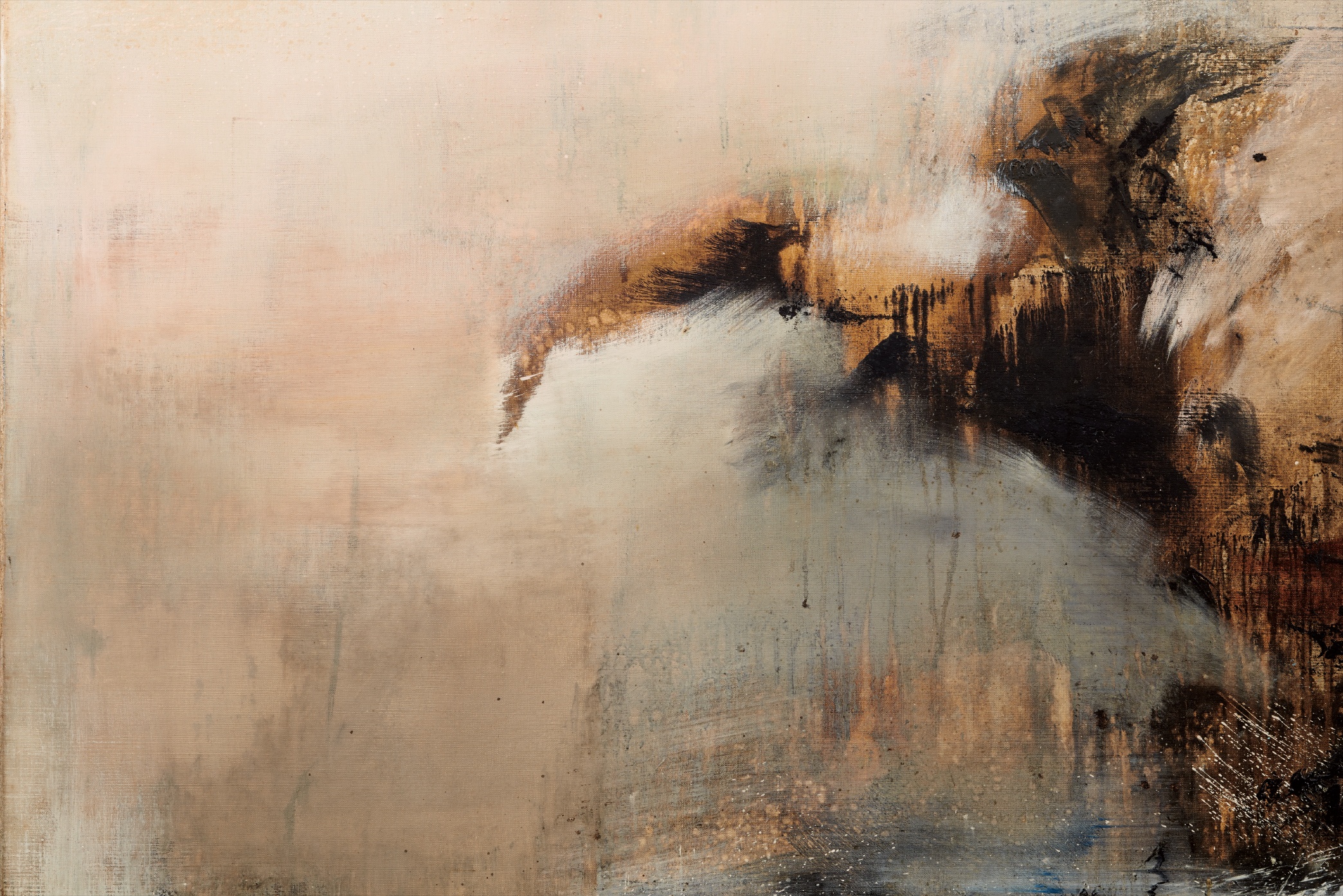
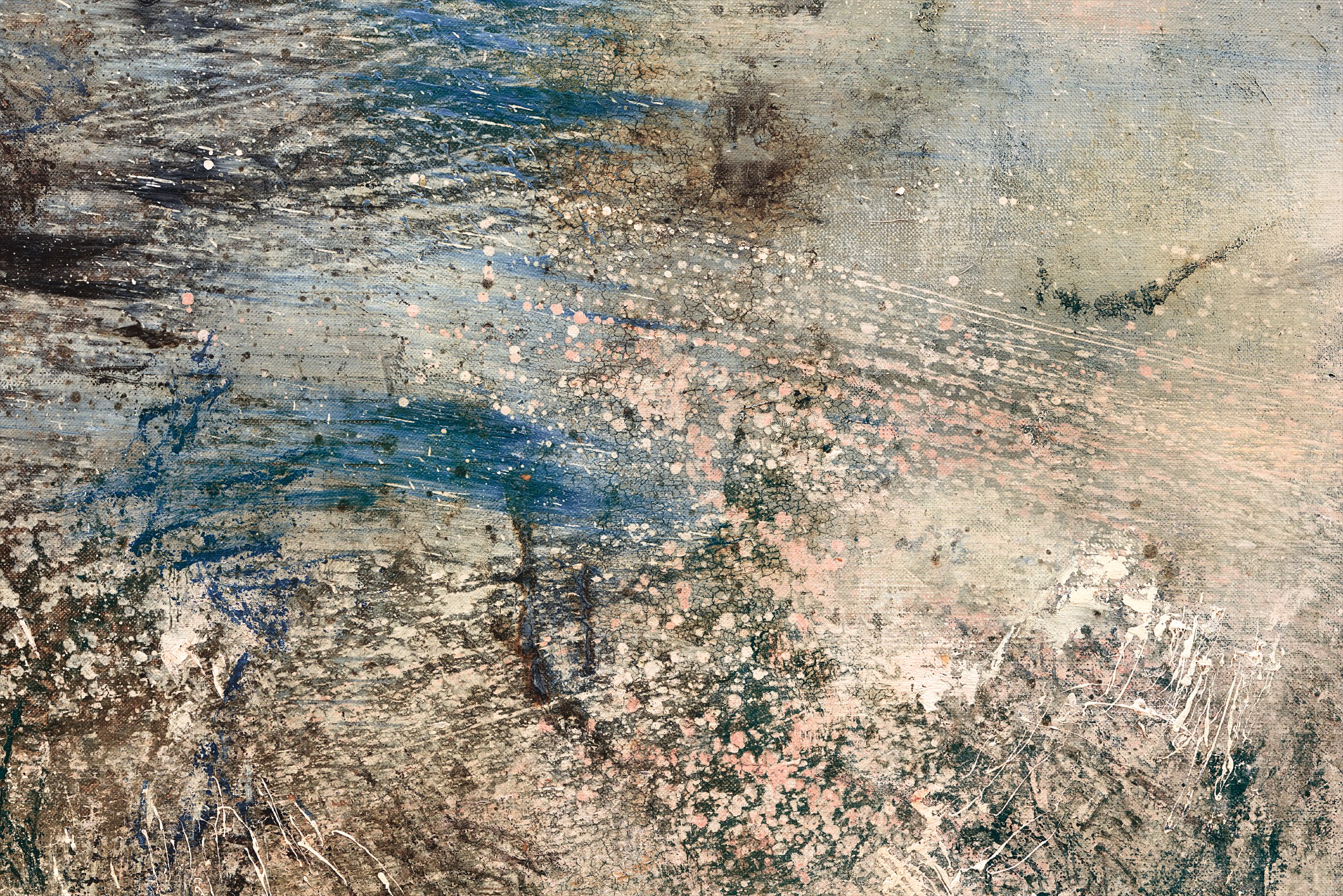
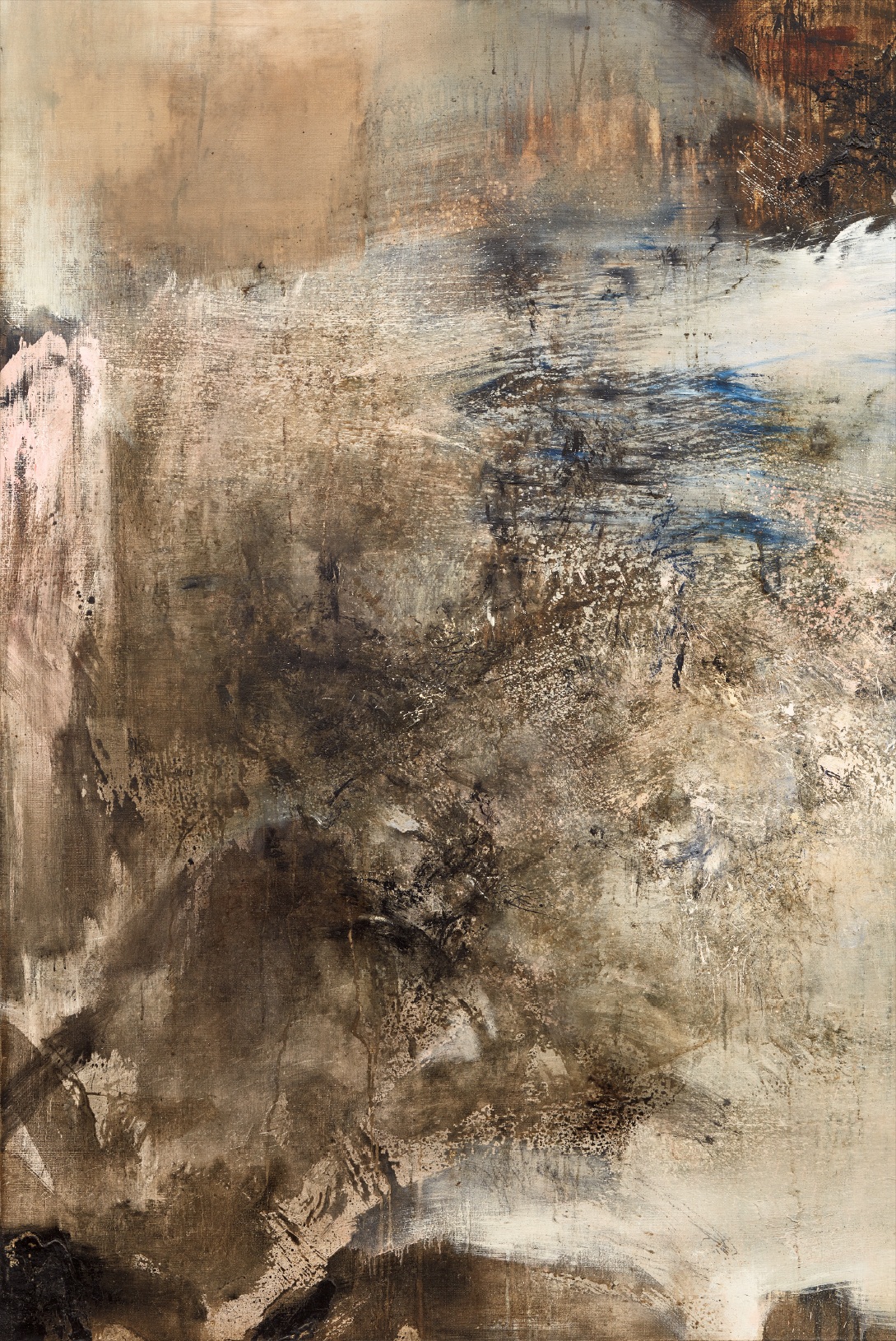
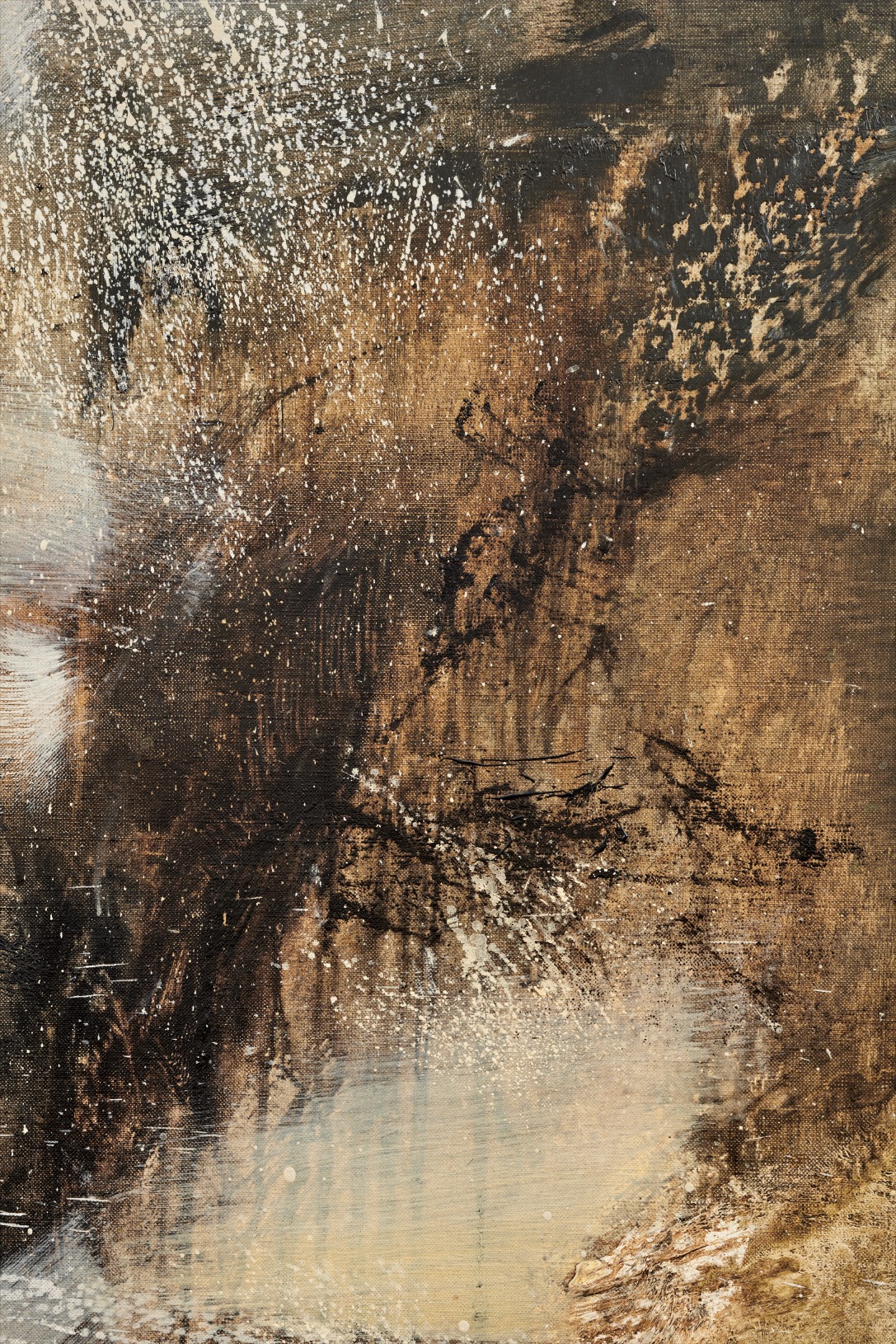







Property of an Important Asian Collector
5Ο◆✱
Zao Wou-Ki
04.01.79
signed ‘Wou-Ki [in Chinese] ZAO’ lower right; further signed and titled ‘ZAO WOU-KI "4.1.79"’ on the reverse
oil on canvas
250 x 260 cm. (98 3/8 x 102 3/8 in.)
Painted in 1979, this work is to be accompanied by a certificate of authenticity issued by the Foundation Zao Wou-Ki.
This work will be referenced in the archive of the Foundation Zao Wou-Ki and will be included in the artist's forthcoming catalogue raisonné prepared by Françoise Marquet and Yann Hendgen (Information provided by Foundation Zao Wou-Ki).
This work will be referenced in the archive of the Foundation Zao Wou-Ki and will be included in the artist's forthcoming catalogue raisonné prepared by Françoise Marquet and Yann Hendgen (Information provided by Foundation Zao Wou-Ki).
Full-Cataloguing
Standing at an impressive height of 2 and a half metres, 04.01.79 is a rare and large-scale work by Zao Wou-Ki, one of the greatest modern Chinese masters. Executed in 1979, the present work embodies the pivotal stylistic transition from the artist’s middle to late period of abstract paintings. The largest painting from the 1970s by the artist to ever come to auction, as well as among the top 10 of his largest works on the market, 04.01.79 is presented to the public for the first time.
Zao Wou-Ki perfectly captures in 04.01.79 the essence of traditional Chinese ink landscapes from the Song and Yuan Dynasties, complemented by the virtues of Western painting in its use of colour and tones. The result is an image of implicit scenic beauty, evoking the grandeur of magnificent landscapes punctuated by high mountains and trees.
Zao Wou-Ki: The Man and His Art
“The myriad things in the universe are conceived by existence; Existence arises from nothingness; and all shall eventually return to the boundless.” – Zao Wou-ki (“Boundless”) was named by his grandfather after the Tao Te Ching, an ancient text by Chinese philosopher Laozi. Despite being the eldest son, Zao Wou-ki did not wish to continue the family business as a banker, and instead grew up especially fond of art. At the age of 15, Zao enrolled in the National Hangzhou Art Academy. Influenced by Western artists like Cézanne and Matisse, he aspired to break free from the confines of traditional Chinese painting. Zao graduated in 1941 after completing his 6-year training programme, after which he was retained by his teacher Lin Fengmian to stay on as a teaching assistant. In hopes of pursuing wider artistic possibilities, the young artist travelled to France in 1948 with his family’s support. This supposed sojourn ultimately became a permanent residency.
Many Chinese artists who came to France to further their education before Zao’s time were part of the work-study programme –a practice of working while studying part-time as a form of self-support that was promoted by China’s Republican government in its early years. The programme was about maintaining a national core of traditional Chinese learning while equipping it with the functionalities of Western learning. Artists like Lin Fengmian and Xu Beihong had returned to China from their studies abroad and founded schools, so as to contribute to the future generations of their nation. As Zao’s teacher, Lin had hoped Zao would likewise return after a few years abroad. However, Zao in his fervent pursuit of art was motivated to stay on in the West. Having been raised in a different time in China from his teachers, artists of Zao Wou-Ki’s generation such as Chu Teh-Chun and himself were no longer strongly driven by the mission to “save the motherland”. Instead, this new generation of young artists were exploring and negotiating conflicts between the art of their own culture and the art they were learning about in Europe. Eventually, as more Asian artists embraced Western mediums and techniques, their own rootedness in their culture led them to strive for a balance between the two distinct styles, and the formation of a unique vocabulary in praxis. However, Zao chose to walk a different path; as a young student, he had been resistant to the enshrinement and replication of traditional Chinese art as taught by his instructors. In Paris, he made no deliberate effort to embed Chinese culture in his practice, for he sought to be seen purely as an artist and not as a foreigner stuck with a geographical label. It is for this reason that Zao refrained from ink painting in the first few years of his residency in the French capital.
In 1951, after an art visit to Switzerland, Zao drew inspiration from Paul Klee’s paintings and started gradually effacing the representational quality of his own works. Very quickly outgrowing the landscapes of his Klee period, the artist came upon the idea of combining Western abstraction with China’s archaic and semiotically rich writing system to develop an artistic idiom of his own. The resultant creation of his Oracle Bone Script series began in 1954. Although Klee’s use of signs and symbols was influenced by Eastern art, his work led Zao deep into the grand edifice of Western art.
From then on, Zao leapt into the world of abstraction. After Cloud (1958), he no longer titled his paintings and instead, only indicated a date on the back of his canvas. By the late 1950s, the artist’s creations were further stripped of descriptiveness and narrative— signs and symbols gradually disappeared.
A Triumph Over Adversity
Around the time 04.01.79 was created, Zao had gained full control of a new stylistic endeavour in conveying a heightened sense of spontaneity and calm in his paintings. As exemplified by the present masterwork, Zao’s portrayal of tranquillity and elegance in nature is unrivalled. This new stylistic phase is highly connected to events that had occurred during that period of his life. The illness and eventual passing of Zao’s second wife in 1972 had left Zao in mourning. Following a period of personal loss and turmoil, it was through this ordeal that the artist started to reconnect with the study of ink wash painting. He resumed painting again in 1973, and began working on large format paintings circa 1977.
Large zones of dark wash call to Zao’s exploration of the ink medium, at the same time also characterises the painting to the specific phase in the artist’s life from 1973 to 1980. Zao himself had said that his style underwent a new transformation from 1973 onwards—he regained peace in his works as compared to the deliberate control depicted in earlier abstract works. The year that 04.01.79 was executed can hence be seen as a period of triumph in reaching a new climax in his artistic pursuits.
The Artistic Accomplishments in 04.01.79
04.01.79’s composition is one of sophisticated, angled trisection –an abstract landscape of tenuous mist girdling precipitous mountains artfully guiding the viewer’s gaze. This is reminiscent of the liubai (to leave blank) aesthetic in Chinese Ink painting, especially as seen in Ni Zan’s minimalistic landscape compositions. Zao also inherits the spirit of the Chinese ink medium through colour, his use of monochromatic tones of black, brown and white reflective of Nature. Peeking through the centre of the landscape are sweeping brushstrokes of warm orange pinks and blue greens, evoking scenes of tumbling mountainside streams. Notably, the darker brown areas on the lower left and just above the centre also illustrate the traditional ink painters’ textured strokes. The work exhibits the calligraphic methods of feibai (flying white), where a brush lightly steeped in ink smudges across silk in order to create a sense of flight; and, perhaps yet, of cunfa (crack technique), whereby a tilted and loaded ink brush layers thick, broad strokes in order to evoke shadows and texture, often utilised to render Nature itself. In 04.01.79 one is witness to all such elements cascading into one another to create an arresting and engulfing composition that serves to anchor our visual associations. The Record of Famous Painters from All the Dynasties by Tang art historian Zhang Yanyuan’s deliberates on the notion of “manipulating ink to produce tones that correspond to the five colours”. This pentad of tones include “scorched ink”, “concentrated ink”, “dense ink”, “light ink” and “clear ink”, of which, each can further vary in terms of the degree of wetness and concentration. With 04.01.79, Zao had taken in such richness of possibilities in the Chinese ink medium, and re-cast it by means of a Western medium with a sense of immediacy.
While 04.01.79 still carries the air of magnificence from Zao Wou-Ki’s earlier years, the artist at this stage paid more attention to crafting pictorial space as a whole, the resulting product infused with lingering, entangling and romantic yet restrained sentiments one might associate with lines from the Tang poet Wang Wei’s Mount Zhongnan, “The white clouds close behind me when I look back. The azure mistiness disappears when I enter it”. According to art critic François Jacob, “[t]he perpetuity of Zao's paintings lies in their questioning of the world”, “their efforts to recreate”, as some of them “display … the birth of light, the invention of water”, or “life indistinctly emerging”, just “beyond the turbulent upheavals of matter”.
Zao’s work very much instantiates the beauty of simplicity that informs Chinese ink painting in its colours and spatial arrangement, depicting energetic brushwork that pulsates along the canvas, and in turn conveys the artist’s sensibilities derived from his connection towards this Eastern art form. Zao had also stated in his autobiography that he was a great admirer of Rembrandt, and was highly inspired by the Western master’s wet-on-wet technique. In re-exploring the intricacies of the Chinese ink, Zao Wou-Ki contemplated how these practices could be blended with the expressive modality of abstract painting. 04.01.79 is a perfect example of Zao’s re-articulation of the ancient spirit onto the canvas. In this piece, the artist had added turpentine to thin out the heavy consistency of his oil paints; the diluted paints offered greater freedom in allowing the artist to generously set down highly translucent washes or layers to create a visual effect akin to the flowing smoothness of ink applied by the ancient literati painters onto rice paper.
Traversing Centuries, Straddling East and West: A Visual Analysis of 04.01.79
Observing 04.01.79, one is confronted with the momentous spiritual dynamism of the painting – one that brings to mind the great classical landscapes of the Song Dynasties. 04.01.79 is potently reminiscent especially of paintings by legendary Song master Li Tang (c. 1050-1130), whose virtuosic technique and sensational brushwork rendered magnificent, atmospheric paintings that evoked otherworldly realms. Li’s style influenced subsequent generations of painters, redefining the genre and status quo of landscape painting.
Zao’s concise brushwork reveals various techniques and sophisticated manoeuvring of colour. The scene ingeniously employs white space to construct a compositional conception of sky and land, while the breathtaking atmosphere of the work envelops viewers with its powerful immersive quality. Standing before 04.01.79, one detects elusive yet compelling traces of picturesque scenery, including mountains, creeks, green trees and scholar’s rocks. Shrouded in a swirling mist, the mountains seem to undulate, the rivers seem to flow, and the pathways beneath the cliff crisscross dynamically into each other. In a mere instant, a stunning and spectacular landscape painting reveals itself from the abstract painting.
In the later works of Joseph Mallord William Turner, the English Romantic painter focused increasingly on the atmospheric qualities of sky, sea, wind and mist, or the rays of light from a flame, and gradually lessened his depiction of physical objects and their details. Critic John Ruskin observed that in these later works, Turner was able to truly grasp hold of the vital pulse of nature. In these paintings, Turner paved the way for Impressionist theory.
The 20th century overseas Chinese artists, including Zao Wou-ki, Chu Teh-Chun and T’ang Haywen (Zeng Haiwen), were all influenced by Turner. Zao's unique and captivating treatment of light and atmosphere, which began in the 1950s and continued on to his more energetic phase in the 1960s, is particularly entrancing. Later in the 1970s, Zao's works reveal a heightened manifestation of Taoist theories of nature and the spiritual qualities of water and air, a testament to the artist's focus of study during this phase of his career. 04.01.79 precisely embodies such preoccupations, evoking a vast, surreal sense of space whilst blurring the boundaries between myth and reality.
While there was an abundance of imagination towards the East in the paintings of Western masters such as Eugène Delacroix, Van Gogh and Matisse, such works were mostly interpretations and portrayals of superficialities— bits of Western modern art’s summation of Orientalism. Zao Wou-Ki’s achievement lies in the fact that he, as a Chinese brought up immersed in Eastern art, was able to draw from his own cultural foundation, and integrate seamlessly Chinese-style landscapes, ink wash painting, as well as the xieyi approach, sensitivities and well-coordinated contrasts of traditional calligraphy with the boldness of Western modernism. To the Westerners, Zao’s paintings had fulfilled their common expectations of the imagined East. At the same time, Zao was also celebrated by the Chinese as an ‘Orientalist’ of the artistic approach and interpretation of Western abstraction, one who unites the spirits of both worlds. Such artistic prowess that straddles both the ancient and the modern, the East and West, can only command our utmost admiration.
Zao Wou-Ki perfectly captures in 04.01.79 the essence of traditional Chinese ink landscapes from the Song and Yuan Dynasties, complemented by the virtues of Western painting in its use of colour and tones. The result is an image of implicit scenic beauty, evoking the grandeur of magnificent landscapes punctuated by high mountains and trees.
Zao Wou-Ki: The Man and His Art
“The myriad things in the universe are conceived by existence; Existence arises from nothingness; and all shall eventually return to the boundless.” – Zao Wou-ki (“Boundless”) was named by his grandfather after the Tao Te Ching, an ancient text by Chinese philosopher Laozi. Despite being the eldest son, Zao Wou-ki did not wish to continue the family business as a banker, and instead grew up especially fond of art. At the age of 15, Zao enrolled in the National Hangzhou Art Academy. Influenced by Western artists like Cézanne and Matisse, he aspired to break free from the confines of traditional Chinese painting. Zao graduated in 1941 after completing his 6-year training programme, after which he was retained by his teacher Lin Fengmian to stay on as a teaching assistant. In hopes of pursuing wider artistic possibilities, the young artist travelled to France in 1948 with his family’s support. This supposed sojourn ultimately became a permanent residency.
Many Chinese artists who came to France to further their education before Zao’s time were part of the work-study programme –a practice of working while studying part-time as a form of self-support that was promoted by China’s Republican government in its early years. The programme was about maintaining a national core of traditional Chinese learning while equipping it with the functionalities of Western learning. Artists like Lin Fengmian and Xu Beihong had returned to China from their studies abroad and founded schools, so as to contribute to the future generations of their nation. As Zao’s teacher, Lin had hoped Zao would likewise return after a few years abroad. However, Zao in his fervent pursuit of art was motivated to stay on in the West. Having been raised in a different time in China from his teachers, artists of Zao Wou-Ki’s generation such as Chu Teh-Chun and himself were no longer strongly driven by the mission to “save the motherland”. Instead, this new generation of young artists were exploring and negotiating conflicts between the art of their own culture and the art they were learning about in Europe. Eventually, as more Asian artists embraced Western mediums and techniques, their own rootedness in their culture led them to strive for a balance between the two distinct styles, and the formation of a unique vocabulary in praxis. However, Zao chose to walk a different path; as a young student, he had been resistant to the enshrinement and replication of traditional Chinese art as taught by his instructors. In Paris, he made no deliberate effort to embed Chinese culture in his practice, for he sought to be seen purely as an artist and not as a foreigner stuck with a geographical label. It is for this reason that Zao refrained from ink painting in the first few years of his residency in the French capital.
In 1951, after an art visit to Switzerland, Zao drew inspiration from Paul Klee’s paintings and started gradually effacing the representational quality of his own works. Very quickly outgrowing the landscapes of his Klee period, the artist came upon the idea of combining Western abstraction with China’s archaic and semiotically rich writing system to develop an artistic idiom of his own. The resultant creation of his Oracle Bone Script series began in 1954. Although Klee’s use of signs and symbols was influenced by Eastern art, his work led Zao deep into the grand edifice of Western art.
From then on, Zao leapt into the world of abstraction. After Cloud (1958), he no longer titled his paintings and instead, only indicated a date on the back of his canvas. By the late 1950s, the artist’s creations were further stripped of descriptiveness and narrative— signs and symbols gradually disappeared.
A Triumph Over Adversity
Around the time 04.01.79 was created, Zao had gained full control of a new stylistic endeavour in conveying a heightened sense of spontaneity and calm in his paintings. As exemplified by the present masterwork, Zao’s portrayal of tranquillity and elegance in nature is unrivalled. This new stylistic phase is highly connected to events that had occurred during that period of his life. The illness and eventual passing of Zao’s second wife in 1972 had left Zao in mourning. Following a period of personal loss and turmoil, it was through this ordeal that the artist started to reconnect with the study of ink wash painting. He resumed painting again in 1973, and began working on large format paintings circa 1977.
Large zones of dark wash call to Zao’s exploration of the ink medium, at the same time also characterises the painting to the specific phase in the artist’s life from 1973 to 1980. Zao himself had said that his style underwent a new transformation from 1973 onwards—he regained peace in his works as compared to the deliberate control depicted in earlier abstract works. The year that 04.01.79 was executed can hence be seen as a period of triumph in reaching a new climax in his artistic pursuits.
The Artistic Accomplishments in 04.01.79
04.01.79’s composition is one of sophisticated, angled trisection –an abstract landscape of tenuous mist girdling precipitous mountains artfully guiding the viewer’s gaze. This is reminiscent of the liubai (to leave blank) aesthetic in Chinese Ink painting, especially as seen in Ni Zan’s minimalistic landscape compositions. Zao also inherits the spirit of the Chinese ink medium through colour, his use of monochromatic tones of black, brown and white reflective of Nature. Peeking through the centre of the landscape are sweeping brushstrokes of warm orange pinks and blue greens, evoking scenes of tumbling mountainside streams. Notably, the darker brown areas on the lower left and just above the centre also illustrate the traditional ink painters’ textured strokes. The work exhibits the calligraphic methods of feibai (flying white), where a brush lightly steeped in ink smudges across silk in order to create a sense of flight; and, perhaps yet, of cunfa (crack technique), whereby a tilted and loaded ink brush layers thick, broad strokes in order to evoke shadows and texture, often utilised to render Nature itself. In 04.01.79 one is witness to all such elements cascading into one another to create an arresting and engulfing composition that serves to anchor our visual associations. The Record of Famous Painters from All the Dynasties by Tang art historian Zhang Yanyuan’s deliberates on the notion of “manipulating ink to produce tones that correspond to the five colours”. This pentad of tones include “scorched ink”, “concentrated ink”, “dense ink”, “light ink” and “clear ink”, of which, each can further vary in terms of the degree of wetness and concentration. With 04.01.79, Zao had taken in such richness of possibilities in the Chinese ink medium, and re-cast it by means of a Western medium with a sense of immediacy.
While 04.01.79 still carries the air of magnificence from Zao Wou-Ki’s earlier years, the artist at this stage paid more attention to crafting pictorial space as a whole, the resulting product infused with lingering, entangling and romantic yet restrained sentiments one might associate with lines from the Tang poet Wang Wei’s Mount Zhongnan, “The white clouds close behind me when I look back. The azure mistiness disappears when I enter it”. According to art critic François Jacob, “[t]he perpetuity of Zao's paintings lies in their questioning of the world”, “their efforts to recreate”, as some of them “display … the birth of light, the invention of water”, or “life indistinctly emerging”, just “beyond the turbulent upheavals of matter”.
Zao’s work very much instantiates the beauty of simplicity that informs Chinese ink painting in its colours and spatial arrangement, depicting energetic brushwork that pulsates along the canvas, and in turn conveys the artist’s sensibilities derived from his connection towards this Eastern art form. Zao had also stated in his autobiography that he was a great admirer of Rembrandt, and was highly inspired by the Western master’s wet-on-wet technique. In re-exploring the intricacies of the Chinese ink, Zao Wou-Ki contemplated how these practices could be blended with the expressive modality of abstract painting. 04.01.79 is a perfect example of Zao’s re-articulation of the ancient spirit onto the canvas. In this piece, the artist had added turpentine to thin out the heavy consistency of his oil paints; the diluted paints offered greater freedom in allowing the artist to generously set down highly translucent washes or layers to create a visual effect akin to the flowing smoothness of ink applied by the ancient literati painters onto rice paper.
Traversing Centuries, Straddling East and West: A Visual Analysis of 04.01.79
Observing 04.01.79, one is confronted with the momentous spiritual dynamism of the painting – one that brings to mind the great classical landscapes of the Song Dynasties. 04.01.79 is potently reminiscent especially of paintings by legendary Song master Li Tang (c. 1050-1130), whose virtuosic technique and sensational brushwork rendered magnificent, atmospheric paintings that evoked otherworldly realms. Li’s style influenced subsequent generations of painters, redefining the genre and status quo of landscape painting.
Zao’s concise brushwork reveals various techniques and sophisticated manoeuvring of colour. The scene ingeniously employs white space to construct a compositional conception of sky and land, while the breathtaking atmosphere of the work envelops viewers with its powerful immersive quality. Standing before 04.01.79, one detects elusive yet compelling traces of picturesque scenery, including mountains, creeks, green trees and scholar’s rocks. Shrouded in a swirling mist, the mountains seem to undulate, the rivers seem to flow, and the pathways beneath the cliff crisscross dynamically into each other. In a mere instant, a stunning and spectacular landscape painting reveals itself from the abstract painting.
In the later works of Joseph Mallord William Turner, the English Romantic painter focused increasingly on the atmospheric qualities of sky, sea, wind and mist, or the rays of light from a flame, and gradually lessened his depiction of physical objects and their details. Critic John Ruskin observed that in these later works, Turner was able to truly grasp hold of the vital pulse of nature. In these paintings, Turner paved the way for Impressionist theory.
The 20th century overseas Chinese artists, including Zao Wou-ki, Chu Teh-Chun and T’ang Haywen (Zeng Haiwen), were all influenced by Turner. Zao's unique and captivating treatment of light and atmosphere, which began in the 1950s and continued on to his more energetic phase in the 1960s, is particularly entrancing. Later in the 1970s, Zao's works reveal a heightened manifestation of Taoist theories of nature and the spiritual qualities of water and air, a testament to the artist's focus of study during this phase of his career. 04.01.79 precisely embodies such preoccupations, evoking a vast, surreal sense of space whilst blurring the boundaries between myth and reality.
While there was an abundance of imagination towards the East in the paintings of Western masters such as Eugène Delacroix, Van Gogh and Matisse, such works were mostly interpretations and portrayals of superficialities— bits of Western modern art’s summation of Orientalism. Zao Wou-Ki’s achievement lies in the fact that he, as a Chinese brought up immersed in Eastern art, was able to draw from his own cultural foundation, and integrate seamlessly Chinese-style landscapes, ink wash painting, as well as the xieyi approach, sensitivities and well-coordinated contrasts of traditional calligraphy with the boldness of Western modernism. To the Westerners, Zao’s paintings had fulfilled their common expectations of the imagined East. At the same time, Zao was also celebrated by the Chinese as an ‘Orientalist’ of the artistic approach and interpretation of Western abstraction, one who unites the spirits of both worlds. Such artistic prowess that straddles both the ancient and the modern, the East and West, can only command our utmost admiration.